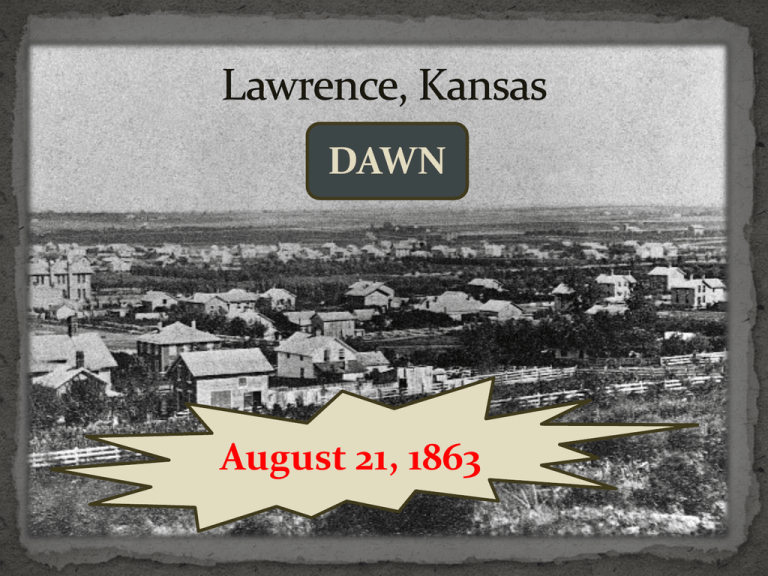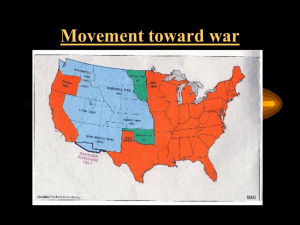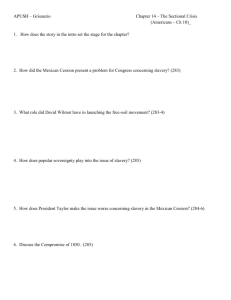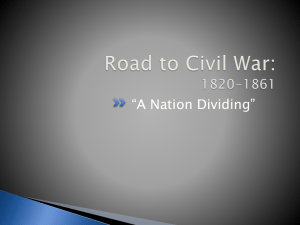DAWN August 21, 1863
advertisement

DAWN August 21, 1863 Over 150 dead … men and boys Some 80 widows Perhaps 200 orphans Town burned William Clarke Quantrill Tonight William Quantrill stands charged with 150 counts of murder. On each count, the penalty sought is death. … we should learn something about the tides of history that brought Quantrill and his men to Mount Gilead overlooking Lawrence on that early August morning. In 1776, the United States declared its independence. Speaking for his countrymen, Thomas Jefferson wrote: “All men are created equal.” In 1787, the United States adopted a Constitution… … and hedged on the promise of equality. All white men were created equal But all black men and women might be made slaves Thomas Jefferson said of it: “I tremble for my country when I reflect that God is just.” And they hoped that, somehow, slavery would wither away. The onset of the Industrial Revolution in England and elsewhere… … and the suitability of the American south for raising cotton made slavery increasingly profitable. SLAVERY BECAME A REGIONAL INSTITUTION By 1820, slavery had effectively been abolished in eleven Northern states. But slavery flourished in eleven Southern states. Increasing numbers of Northern voices were raised against slavery. And the nation was expanding West. -- John Quincy Adams 1820: The Missouri Compromise Admitted Missouri as a Slave State. Admitted Maine as a Free State. If slavery were barred from new states formed out of the western territories, the South would be outnumbered in Congress and slavery itself might be imperiled. So, for decades new states were admitted in pairs – one slave and one free. Barred slavery from territories north of southern border of Missouri. Congress passed the Kansas-Nebraska Act: It created the Kansas and Nebraska Territories, and decreed Settlers would vote on whether to enter Union as free or slave state. Everyone knew Nebraska would come in as a free state… Stephen A. Douglas 1854: The Race Was On Eastern groups offered abolitionist families money to move to Kansas Pro-slavery Missourians living along the border staked claims in Kansas “We will have the Devil to pay in Kansas and this State. We are organizing to meet [the Free Staters’] organization. We will be compelled to shoot, burn, and hang. But the thing will soon be over.” Missourians were unwilling to have Kansas elections decided by a peaceful immigration race. -- U.S. Senator (MO) David Rice Atchison to U.S. Secretary of War Jefferson Davis (1854) B.F Stringfellow to Missourians along the Kansas border: “I advise you one and all to enter every election district in Kansas and vote at the point of the bowie knife and revolver.” Despite there being only about 3,000 qualified voters in Kansas, more than 6,200 votes were cast… …5,427 for proslavery candidates. The Administration of President Franklin Pierce accepts the election results anyway. The new pro-slavery legislature immediately passes laws that legalize slavery in Kansas and criminalize opposition to the peculiar institution. Kansas Free Soilers respond by electing their own state legislature, which meets in Topeka. It is led by men like Jim Lane, an ambitious, fire-breathing orator. Jim Lane President Franklin Pierce The administration of President Franklin Pierce sides with the pro-slavery Kansas legislature and declares the Free Soil legislature a “treasonable insurrection.” Enter John Brown A deeply religious abolitionist who has devoted his life to the destruction of slavery. In 1855, John Brown follows his sons to Kansas to join the fight. The Free-State stronghold of Lawrence, Kansas is sacked (for the first time) by a pro-slavery posse of Missourians. Buildings burned. One person killed. Outraged by the attack on Lawrence, John Brown and a group of Free Soil Kansans sweep down the Creek, pull five pro-slavery men from their homes … and murder them. Violence escalates Pro- and anti-slavery men fight pitched battles … and commit hundreds of unremembered brutalities. The Kansas Territory becomes known throughout the world as “Bleeding Kansas.” In 1858, pro-slavery Missourians murder five unarmed Kansas Free Soilers on the Marais de Cygnes Creek . But for the next two years, relative calm prevails on the border. Abraham Lincoln is elected President. Convinced that Lincoln’s election would doom their social order, Southern states secede. They form the Confederate States of America … and elect Jefferson Davis as their President South Carolinians fire on Fort Sumter Missouri is a slave state But has large numbers of anti-slavery inhabitants Even many of its slaveholders are reluctant to secede But Missouri’s governor and many of its legislators favor secession Gov. Claiborne Fox Jackson Unionists strike first: Seize federal armory in St. Louis Drive proConfederate state officials out of St. Louis Then Jefferson City. Camp Jackson, May 1861 Hastily assembled proUnion and proConfederate armies clash across Missouri. Led by General Sterling Price, the Confederates have early successes. General Price’s Confederates seize Lexington, Missouri. En route to Lexington, the Confederates defeat a unit of pro-Union Kansans raised by Jim Lane. Repulsed by Gen. Price’s Confederates, Jim Lane takes his men on a raid into Price’s rear. They attack Price’s supply lines … and settlements believed to be pro-secession. In Osceola, Lane’s men burn and loot the town, and allegedly shoot a number of men who resist them. By October 1861, Price’s Confederate Army was driven from Missouri General Sterling Price Pro-Southern Missourians had three choices: Go south to fight with the regular Confederate Army Go home, lay down their arms, and accept that Missouri remained in the Union Or go into the bush and fight a guerrilla war … and the Border War burst into flame again. Murderer? Terrorist? Soldier?




